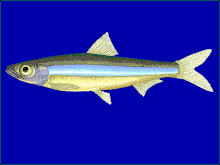Lake Tanganyika sardine
| Lake Tanganyika sardine | |
|---|---|
 |
|
| Scientific classification | |
| Kingdom: | Animalia |
| Phylum: | Chordata |
| Class: | Actinopterygii |
| Order: | Clupeiformes |
| Family: | Clupeidae |
| Genus: | Limnothrissa |
| Species: | L. miodon |
| Binomial name | |
|
Limnothrissa miodon (Boulenger, 1906) |
|
| Synonyms | |
|
|
The Lake Tanganyika sardine (Limnothrissa miodon) is a species of freshwater fish in the Clupeidae family which was endemic to Lake Tanganyika but which has now been introduced to other lakes in Africa as a food source. It is monotypic within the genus Limnothrissa. It and the Lake Tanganyika sprat are known collectively as kapenta.
As its name suggests the Lake Tanganyika sardine was endemic to Lake Tanganyika extending into the lower reaches of the Malagarasi River. It has been introduced to Lake Kivu in Rwanda and the man-made Lake Kariba in the Zambezi valley between Zambia and Zimbabwe and more recently into the Itezhi-Tezhi Dam in Zambia. It has colonised Cahora Bassa lake in Mozambique from Lake Kariba, the fish have survived transit through the hyro-electric turbines in the Kariba Dam and made their way downstream to colonise Cahora Bassa.
A typical clupeid, this is a small silver fish with a brighter stripe down the lateral line, a broad snout with tapering sides. It has a relatively large swim bladder which allows it to travel large vertical distances in the water column. The maximum length is 17 cm, but most specimens are about 10 cm long and they are thought to be sexually mature at 6.8 cm.
Lake Tanganyika sardines undergo vertical migrations, spending the day in tight shoals in deep water, rising to the surface at dawn and dusk while spending the remainder of the night dispersed widely throughout the pelagic waters, although in Lake Kivu the fish move to the surface during the early morning and late afternoon. It is thought that these movements follow those of its food source, zooplankton but in Lake Kariba they do not. It seems that the fish and the plankton are responding to the same stimuli meaning that they occur in the same locations at similar times. One theory is that this may be a reaction to light intensity and be a protection against predators, similar to that reported in marine clupeids.
...
Wikipedia

